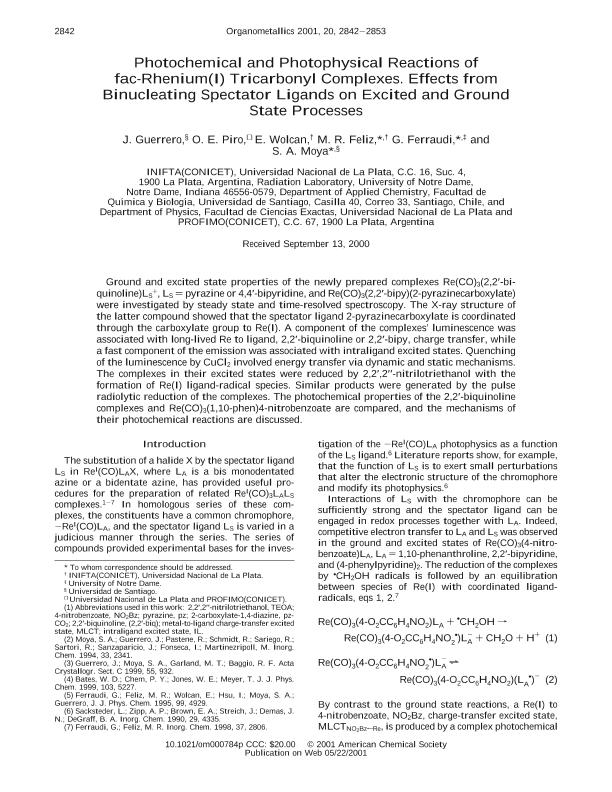Artículo
Photochemical and Photophysical Reactions of f ac -Rhenium(I) Tricarbonyl Complexes. Effects from Binucleating Spectator Ligands on Excited and Ground State Processes
Guerrero, J.; Piro, Oscar Enrique ; Wolcan, Ezequiel
; Wolcan, Ezequiel ; Feliz, Mario Ruben; Ferraudi, G.; Moya, S. A.
; Feliz, Mario Ruben; Ferraudi, G.; Moya, S. A.
 ; Wolcan, Ezequiel
; Wolcan, Ezequiel ; Feliz, Mario Ruben; Ferraudi, G.; Moya, S. A.
; Feliz, Mario Ruben; Ferraudi, G.; Moya, S. A.
Fecha de publicación:
12/2001
Editorial:
American Chemical Society
Revista:
Organometallics
ISSN:
0276-7333
Idioma:
Inglés
Tipo de recurso:
Artículo publicado
Clasificación temática:
Resumen
Ground and excited state properties of the newly prepared complexes Re(CO)3(2,2¢-biquinoline) LS3(2,2¢-biquinoline) LSS +, LS ) pyrazine or 4,4¢-bipyridine, and Re(CO)3(2,2¢-bipy)(2-pyrazinecarboxylate) were investigated by steady state and time-resolved spectroscopy. The X-ray structure of the latter compound showed that the spectator ligand 2-pyrazinecarboxylate is coordinated through the carboxylate group to Re(I). A component of the complexes’ luminescence was associated with long-lived Re to ligand, 2,2¢-biquinoline or 2,2¢-bipy, charge transfer, while a fast component of the emission was associated with intraligand excited states. Quenching of the luminescence by CuCl2 involved energy transfer via dynamic and static mechanisms. The complexes in their excited states were reduced by 2,2¢,2¢¢-nitrilotriethanol with the formation of Re(I) ligand-radical species. Similar products were generated by the pulse radiolytic reduction of the complexes. The photochemical properties of the 2,2¢-biquinoline complexes and Re(CO)3(1,10-phen)4-nitrobenzoate are compared, and the mechanisms of their photochemical reactions are discussed., LS ) pyrazine or 4,4¢-bipyridine, and Re(CO)3(2,2¢-bipy)(2-pyrazinecarboxylate) were investigated by steady state and time-resolved spectroscopy. The X-ray structure of the latter compound showed that the spectator ligand 2-pyrazinecarboxylate is coordinated through the carboxylate group to Re(I). A component of the complexes’ luminescence was associated with long-lived Re to ligand, 2,2¢-biquinoline or 2,2¢-bipy, charge transfer, while a fast component of the emission was associated with intraligand excited states. Quenching of the luminescence by CuCl2 involved energy transfer via dynamic and static mechanisms. The complexes in their excited states were reduced by 2,2¢,2¢¢-nitrilotriethanol with the formation of Re(I) ligand-radical species. Similar products were generated by the pulse radiolytic reduction of the complexes. The photochemical properties of the 2,2¢-biquinoline complexes and Re(CO)3(1,10-phen)4-nitrobenzoate are compared, and the mechanisms of their photochemical reactions are discussed.¢-biquinoline or 2,2¢-bipy, charge transfer, while a fast component of the emission was associated with intraligand excited states. Quenching of the luminescence by CuCl2 involved energy transfer via dynamic and static mechanisms. The complexes in their excited states were reduced by 2,2¢,2¢¢-nitrilotriethanol with the formation of Re(I) ligand-radical species. Similar products were generated by the pulse radiolytic reduction of the complexes. The photochemical properties of the 2,2¢-biquinoline complexes and Re(CO)3(1,10-phen)4-nitrobenzoate are compared, and the mechanisms of their photochemical reactions are discussed.2 involved energy transfer via dynamic and static mechanisms. The complexes in their excited states were reduced by 2,2¢,2¢¢-nitrilotriethanol with the formation of Re(I) ligand-radical species. Similar products were generated by the pulse radiolytic reduction of the complexes. The photochemical properties of the 2,2¢-biquinoline complexes and Re(CO)3(1,10-phen)4-nitrobenzoate are compared, and the mechanisms of their photochemical reactions are discussed.¢,2¢¢-nitrilotriethanol with the formation of Re(I) ligand-radical species. Similar products were generated by the pulse radiolytic reduction of the complexes. The photochemical properties of the 2,2¢-biquinoline complexes and Re(CO)3(1,10-phen)4-nitrobenzoate are compared, and the mechanisms of their photochemical reactions are discussed.¢-biquinoline complexes and Re(CO)3(1,10-phen)4-nitrobenzoate are compared, and the mechanisms of their photochemical reactions are discussed.3(1,10-phen)4-nitrobenzoate are compared, and the mechanisms of their photochemical reactions are discussed.
Archivos asociados
Licencia
Identificadores
Colecciones
Articulos(IFLP)
Articulos de INST.DE FISICA LA PLATA
Articulos de INST.DE FISICA LA PLATA
Citación
Guerrero, J.; Piro, Oscar Enrique; Wolcan, Ezequiel; Feliz, Mario Ruben; Ferraudi, G.; et al.; Photochemical and Photophysical Reactions of f ac -Rhenium(I) Tricarbonyl Complexes. Effects from Binucleating Spectator Ligands on Excited and Ground State Processes; American Chemical Society; Organometallics; 20; 13; 12-2001; 2842-2853
Compartir
Altmétricas



